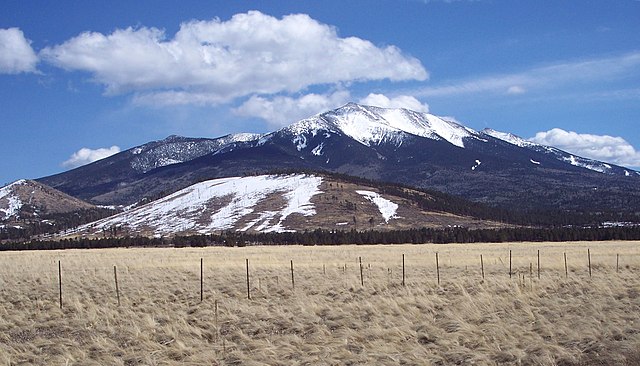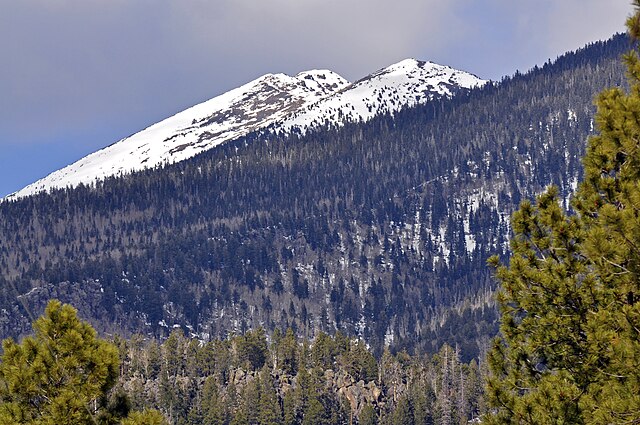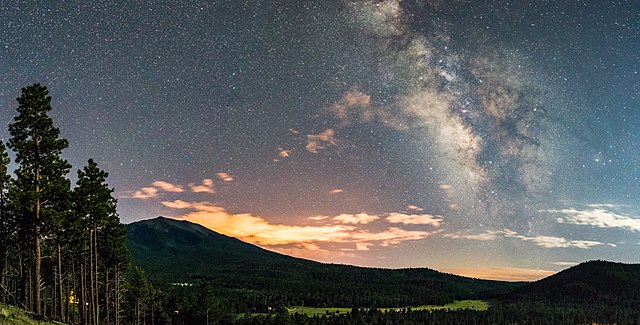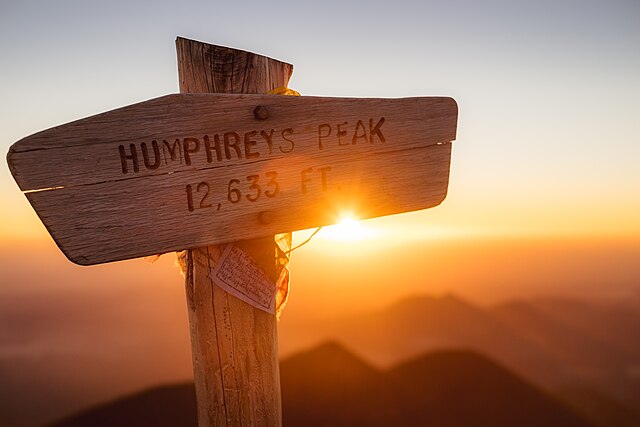Are you ready to stand on top of Arizona? Humphreys Peak beckons adventurers from around the world, offering an unforgettable journey to the state’s highest point. This majestic summit isn’t just another hike – it’s a transformative experience that challenges your limits while rewarding you with breathtaking panoramic views that stretch for miles.
What Makes Humphreys Peak Arizona’s Crown Jewel?
Humphreys Peak stands as Arizona’s ultimate outdoor achievement, drawing thousands of hikers annually who seek to conquer its challenging slopes. But what exactly makes this mountain so special? The answer lies in its unique combination of accessibility, natural beauty, and the incredible sense of accomplishment that comes with reaching Arizona’s rooftop.
Geographic Location and Significance
Located in the Coconino National Forest near Flagstaff, Humphreys Peak forms part of the San Francisco Peaks, an ancient volcanic field that has shaped Northern Arizona’s landscape for millions of years. This sacred mountain holds deep cultural significance for numerous Native American tribes, including the Hopi, Navajo, and Zuni peoples, who consider it a holy site.
The peak sits approximately 10 miles northwest of Flagstaff, making it easily accessible for day trips or weekend adventures. Its prominence in the region’s skyline makes it a natural landmark that has guided travelers for centuries. The mountain’s volcanic origins have created unique geological features that hikers encounter throughout their journey to the summit.
Elevation and Record-Breaking Heights
Rising to an impressive 12,633 feet above sea level, Humphreys Peak claims the title of Arizona’s highest point. This elevation places it among the most significant peaks in the American Southwest, offering hikers a genuine high-altitude experience without requiring technical climbing skills.
The dramatic elevation gain from Flagstaff (approximately 7,000 feet) to the summit creates distinct ecological zones that hikers traverse during their ascent. You’ll witness a remarkable transformation from ponderosa pine forests to alpine tundra conditions near the peak, making every step a journey through different worlds.
Planning Your Humphreys Peak Adventure

Success on Humphreys Peak requires careful planning and preparation. The mountain’s high elevation and unpredictable weather patterns demand respect and thorough preparation from all who attempt to reach its summit.
Best Time to Hike Humphreys Peak
Timing your Humphreys Peak adventure correctly can make the difference between an enjoyable experience and a dangerous ordeal. The hiking season typically runs from late June through early October, though conditions can vary significantly based on snowfall patterns and weather systems.
Summer Hiking Conditions
Summer months offer the most favorable conditions for hiking Humphreys Peak. July through September typically provide the most stable weather, with afternoon thunderstorms being the primary concern. Morning starts are essential during summer months, as lightning activity increases significantly after noon.
Temperatures at the summit can be 20-30 degrees cooler than at the trailhead, so layered clothing remains essential even during summer months. The high altitude means UV exposure is intense, requiring sun protection and plenty of water.
Winter Considerations
Winter hiking on Humphreys Peak is reserved for experienced mountaineers with proper winter climbing equipment. Snow can accumulate to depths of several feet, and avalanche conditions may exist. The trail becomes significantly more dangerous and is not recommended for casual hikers during winter months.
Essential Permits and Regulations
Currently, Humphreys Peak doesn’t require special permits for day hiking, but this could change as popularity increases. However, hikers must follow Leave No Trace principles and respect wilderness regulations. Group size limits apply, and overnight camping requires proper permits.
The Coconino National Forest manages the area, and regulations include staying on designated trails, packing out all trash, and respecting wildlife. Dogs are allowed but must remain on leash and owners must clean up after them.
Humphreys Peak Trail Guide

The journey to Humphreys Peak’s summit follows a well-established trail that has been refined over decades of use. Understanding the trail’s characteristics helps hikers prepare mentally and physically for the challenge ahead.
Trailhead Access and Parking
The Humphreys Peak Trailhead is located along Highway 180, approximately 7 miles north of Flagstaff. The parking area can accommodate several dozen vehicles, but it fills quickly during peak season, especially on weekends. Arriving early (before 6 AM) is highly recommended to secure parking and avoid afternoon thunderstorms.
The trailhead sits at approximately 9,300 feet elevation, meaning you’re already well above Flagstaff’s elevation when you begin hiking. Basic facilities include restrooms and information boards, but no water sources are available.
Trail Difficulty and Distance
The Humphreys Peak Trail stretches approximately 4.8 miles to the summit, making it a 9.6-mile round trip adventure. This isn’t a casual day hike – it’s a serious undertaking that typically requires 6-8 hours to complete, depending on your fitness level and weather conditions.
The trail is rated as strenuous due to its length, elevation gain, and high-altitude conditions. While the path is well-maintained and clearly marked, the physical demands shouldn’t be underestimated. Many hikers find the descent particularly challenging on their knees and ankles.
Elevation Gain Breakdown
The total elevation gain from trailhead to summit is approximately 3,333 feet. The trail gains elevation steadily throughout its length, with the steepest sections occurring in the final two miles. The average grade is manageable, but the sustained climb at high altitude challenges even experienced hikers.
The first mile offers a gentle warm-up through dense forest, while miles two and three increase in difficulty as you climb above treeline. The final 1.8 miles to the summit are the most challenging, with loose scree and exposed conditions testing your endurance.
Technical Challenges
While Humphreys Peak doesn’t require technical climbing skills, several sections present challenges that hikers should be prepared for. The final approach involves hiking over loose volcanic rock (scree) that can be unstable underfoot. This section requires careful foot placement and steady balance.
Weather conditions can change rapidly, creating additional technical challenges. Fog, wind, and sudden temperature drops can make navigation difficult and dangerous. GPS devices or smartphone apps with offline maps provide valuable backup navigation tools.
What to Expect During Your Hike
Your journey to Humphreys Peak’s summit takes you through diverse ecosystems and constantly changing scenery. Understanding what lies ahead helps you appreciate the experience and prepare for the challenges you’ll encounter.
Flora and Fauna Along the Trail
The trail showcases Arizona’s remarkable biodiversity as you ascend through distinct elevation zones. You’ll begin in dense stands of ponderosa pine, Douglas fir, and white fir trees that create a cool, shaded environment for the first portion of your hike.
As elevation increases, you’ll encounter subalpine species including Engelmann spruce and corkbark fir. These hardy trees survive in harsh conditions and create a magical atmosphere with their distinctive appearance and sweet fragrance.
Wildlife sightings might include elk, deer, various bird species, and occasionally black bears. Marmots and pikas inhabit the rocky areas near the summit, while hawks and eagles soar overhead. Always maintain safe distances from wildlife and follow proper food storage protocols.
Weather Patterns and Conditions
Mountain weather is notoriously unpredictable, and Humphreys Peak exemplifies this reality. Conditions can change from sunny and pleasant to dangerous in minutes, especially during monsoon season (July-September).
Morning typically offers the most stable conditions, with clear skies and calm winds. By early afternoon, clouds begin building, and thunderstorms become increasingly likely. Lightning poses a serious threat above treeline, making early starts essential for safety.
Temperature variations are extreme, with summit temperatures often 20-30 degrees cooler than at the trailhead. Wind can make conditions feel even colder, and sudden weather changes can catch unprepared hikers off guard.
Safety Tips for Humphreys Peak
Mountain safety isn’t optional – it’s essential for a successful and enjoyable Humphreys Peak adventure. The high altitude, remote location, and unpredictable weather create real risks that require serious preparation and constant awareness.
Altitude Sickness Prevention
Altitude sickness affects many hikers attempting Humphreys Peak, as the summit’s elevation of 12,633 feet can cause significant physiological stress. Symptoms include headaches, nausea, dizziness, and fatigue. Prevention strategies include gradual acclimatization, staying hydrated, and recognizing early symptoms.
If you’re traveling from sea level, consider spending a day or two in Flagstaff before attempting the hike. This allows your body to begin adjusting to the reduced oxygen levels. During the hike, maintain a steady pace and take regular rest breaks to avoid overexertion.
Emergency Preparedness
Cell phone coverage is sporadic on Humphreys Peak, making self-reliance crucial for emergency situations. Carry a well-stocked first aid kit, emergency shelter, and signaling devices. Inform someone of your hiking plans and expected return time.
Weather emergencies pose the greatest risk, with lightning strikes and hypothermia being primary concerns. If thunderstorms develop, retreat immediately to lower elevations and seek shelter in dense forest areas. Never attempt to wait out storms above treeline.
Photography and Scenic Views
Humphreys Peak offers some of Arizona’s most spectacular photography opportunities, with panoramic views that stretch across multiple states. The summit provides a 360-degree perspective that includes the Grand Canyon, Sedona’s red rocks, and distant mountain ranges.
Best Photo Spots on the Trail
Several locations along the trail offer exceptional photography opportunities. The meadows at approximately 11,000 feet provide beautiful foreground elements with wildflowers during summer months. The rocky outcrops near treeline offer dramatic compositions with twisted trees and expansive views.
The summit itself is the ultimate photography destination, with views extending over 100 miles in clear conditions. The ancient volcanic landscape creates unique geological features that make for compelling photographic subjects.
Sunrise and Sunset Opportunities

While most hikers complete Humphreys Peak as a day hike, the summit offers incredible sunrise and sunset opportunities for those willing to attempt more challenging timing. Sunrise from the summit is particularly spectacular, with the first light illuminating the Grand Canyon and surrounding peaks.
Sunset photography requires careful planning and emergency preparedness, as descending in darkness significantly increases risks. Headlamps, extra batteries, and navigation tools become essential for safe descent.
Accommodations Near Humphreys Peak
Your Humphreys Peak adventure requires comfortable accommodations that allow for proper rest and preparation. Flagstaff offers numerous options for every budget and preference.
Flagstaff Lodging Options
Flagstaff provides excellent lodging options ranging from budget motels to luxury hotels. Historic downtown hotels offer charm and character, while modern chain hotels provide predictable amenities and comfort. Many accommodations cater specifically to outdoor enthusiasts with early breakfast options and gear storage.
Local bed and breakfasts offer personalized service and insider knowledge about hiking conditions. Many hosts are experienced hikers themselves and can provide valuable advice about timing, weather, and trail conditions.
Camping Alternatives
Several campgrounds near Humphreys Peak offer opportunities to sleep under the stars before your summit attempt. The Coconino National Forest operates multiple campgrounds within a short drive of the trailhead.
Camping allows you to start your hike earlier and reduces travel time on hiking day. However, overnight camping requires proper reservations during peak season, and campground facilities vary significantly in available amenities.
Local Attractions and Activities
Your Humphreys Peak adventure can be part of a larger Northern Arizona exploration, with numerous attractions and activities complementing your hiking experience.
Exploring the San Francisco Peaks
The San Francisco Peaks offer numerous hiking opportunities beyond Humphreys Peak. The Arizona Snowbowl provides summer scenic lift rides for those seeking mountain views without the strenuous hike. The Inner Basin Trail offers a more moderate hiking alternative with spectacular aspen groves.
Sunset Crater Volcano National Monument showcases the region’s volcanic history with fascinating geological features and educational programs. The monument’s proximity to Humphreys Peak makes it an excellent addition to your itinerary.
Flagstaff’s Historic Downtown
Flagstaff’s historic downtown district offers excellent dining, shopping, and cultural attractions. The town’s railroad heritage is preserved in museums and historic buildings that tell the story of the American West’s development.
Local restaurants specialize in southwestern cuisine and offer hearty meals perfect for refueling after your mountain adventure. Craft breweries provide relaxation and celebration opportunities for successful summit attempts.
Conclusion
Humphreys Peak stands as Arizona’s ultimate mountain adventure, offering hikers the opportunity to reach the state’s highest point while experiencing diverse ecosystems and breathtaking views. This challenging but rewarding hike requires careful preparation, respect for mountain conditions, and commitment to safety protocols.
The journey to Arizona’s rooftop isn’t just about reaching the summit – it’s about personal growth, natural beauty appreciation, and the satisfaction of completing a significant physical challenge. Whether you’re a seasoned mountaineer or an ambitious hiker looking to push your limits, Humphreys Peak delivers an unforgettable experience that will leave you planning your return visit.
Remember that successful mountain adventures depend on preparation, flexibility, and respect for nature’s power. Start training early, check weather conditions religiously, and always prioritize safety over summit success. The mountain will be there for future attempts, but your safety depends on making smart decisions throughout your adventure.
Frequently Asked Questions
Q: How long does it take to hike Humphreys Peak?
A: Most hikers require 6-8 hours to complete the 9.6-mile round trip hike to Humphreys Peak’s summit. Your actual time depends on fitness level, weather conditions, and rest breaks. Plan for a full day adventure and start early to avoid afternoon thunderstorms.
Q: Do I need special permits to hike Humphreys Peak?
A: Currently, no special permits are required for day hiking Humphreys Peak. However, you must follow Coconino National Forest regulations and Leave No Trace principles. Group size restrictions apply, and overnight camping requires proper permits.
Q: What’s the best time of year to hike Humphreys Peak?
A: The optimal hiking season runs from late June through early October, with July through September offering the most stable weather conditions. Winter hiking is extremely dangerous and not recommended for casual hikers due to snow, ice, and avalanche risks.
Q: How difficult is the Humphreys Peak trail?
A: The trail is rated as strenuous due to its 9.6-mile length, 3,333-foot elevation gain, and high-altitude conditions. While no technical climbing skills are required, the hike demands good physical fitness, proper preparation, and respect for mountain conditions.
Q: What should I bring for a Humphreys Peak hike?
A: Essential items include layered clothing, waterproof jacket, plenty of water (3-4 liters), high-energy snacks, first aid kit, headlamp, sun protection, and navigation tools. Weather can change rapidly, so prepare for various conditions even during summer months.

